Warrior was a British anthology comic book in the 1980s edited by Dez Skinn and which rivaled 2000 A.D. (the source of Judge Dredd, among other things) in terms of critical acclaim for its stories, but never had the same sales as the other magazine. The contributors to the title were a who’s who of British creators in the 1980s: John Bolton, Steve Dillon, Garry Leach, Steve Moore, Grant Morrison, Paul Neary, Steve Parkhouse, John Ridgway, and many others—notably Alan Moore, who ran The Bojeffries Saga, Marvelman, Warpsmith, and V for Vendetta in the magazine.
At least until it was cancelled.
A dystopian science fiction story, Moore’s tale was at least partly inspired by the reign of Margaret Thatcher as prime minister of the United Kingdom as well as the Cold War paranoia about nuclear war and what the world would look like after the bombs flew. It was artist David Lloyd who came up with the notion of V wearing a Guy Fawkes mask.
Unfortunately, Warrior was cancelled in 1985 before they could finish the storyline. (Ditto Marvelman, as it happens.) There was a great hue and cry for the story to be finished by its fans, and finally DC—flush from the success of Moore’s Watchmen—offered to let them complete it. DC put out a ten-issue miniseries that reprinted the Warrior stories and then had Moore and Lloyd finish it. DC also printed it in color—Warrior was a black-and-white magazine.
While not as big a hit as Watchmen, V for Vendetta was quite popular in the U.S. even as the Berlin Wall was coming down and the Soviet Union collapsed.
Buy the Book
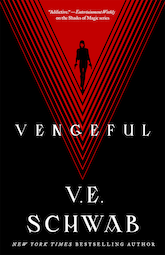

Vengeful
Joel Silver bought the rights to both Watchmen and V for Vendetta in 1988. Like so many comic book properties, it languished in production hell throughout the end of the 20th century and finally got made in the 21st, a running theme in this rewatch. In the case of V, it was the Wachowskis’ love for the source material combined with their ability to more or less write their own ticket after the success of the Matrix movies that enabled them to work with Silver to put the movie together.
James McTeigue was hired to direct the Wachowskis’ script, and a first-rate cast was assembled, including Natalie Portman as Evey, John Hurt as the high chancellor (an ironic bit of casting, since Hurt played Winston Smith, pretty much the opposite role, in another dystopian adaptation, 1984), Stephen Rea as Finch, and Stephen Fry as Deitrich. Hugo Weaving plays V, taking on the role after James Purefoy quit after a few weeks of filming, as acting in the mask proved more than he was willing to deal with. Some footage of Purefoy was used in the final film—all of Weaving’s dialogue was looped in later in any case.
Moore, having had a falling out with DC, having been utterly disgusted with film adaptations of The League of Extraordinary Gentlemen and From Hell, and having intensely disliked the Wachowskis’ script, disassociated himself completely from the movie. He refused to be credited as the co-creator of the original comic on which it was based (only Lloyd is credited in the film), and refused to accept any money for it.
Since the Wachowskis were writing a screenplay for a movie that would be released in the mid-2000s, it wound up being a more direct critique of the U.S. in the George W. Bush era of post-9/11 insanity, instead of the UK in the Thatcher era of nuclear paranoia. The movie wound up being quite popular critically and financially, though it was also wracked with controversy, as any good (or even bad) political film would be.
“Both victim and villain”
V for Vendetta
Written by the Wachowskis
Directed by James McTeigue
Produced by Joel Silver and Grant Hill and the Wachowskis
Original release date: March 17, 2006
We open with a flashback to Guy Fawkes and the Gunpowder Plot, then we see both Evey Hammond and V getting dressed (the former in a nice black dress, the latter in a Guy Fawkes mask, fedora, and black wig) while watching Lewis Prothero’s government propaganda TV show. Evey goes out after curfew for a dinner date with her boss, Gordon Deitrich, but is stopped by people she thinks are muggers, but who turn out to be law officers (“Fingermen”), who want to have their way with her before arresting her.
However, V arrives and takes care of the officers and saves her life. He invites her to a rooftop to watch the destruction of the Old Bailey, which he has orchestrated (literally, as he’s commandeered the government speakers on the streets to play the 1812 Overture). The government, led by High Chancellor Sutler, covers this up by saying it was a deliberate demolition, but a lot of people don’t buy it.
After watching the event with V, Evey goes back home. The next day, she reports to work and tells Deitrich that she’d seen Fingermen out and didn’t want to risk being caught, which was almost true.
Inspector Finch, who is in charge of investigating crimes, finds footage of the terrorist whom they believe blew up the Old Bailey, and while they can’t identify him, they can identify Evey. They break into her apartment first, but she’s not there, so they head to her office at BTN. V also is at BTN, threatening to blow up the place with explosives attached to his chest, and sends out a message to all stations. He knew the High Chancellor would send a message to everyone on all channels, as it were, so he is able to get out his own message: that he blew up the Old Bailey on the 5th of November, and that he urges everyone to gather at the House of Parliament a year hence.
Finch and his deputy, Dominic, arrive in pursuit of Evey, and try to stop V, but he has put masks, hats, and wigs on everyone in the studio, so no one knows who is who. One of the officers shoots an innocent in the Fawkes mask, and later the government uses that footage as “proof” that the terrorist is quite dead.
V himself is almost caught, but Evey saves him by distracting Dominic with mace. But Evey is knocked unconscious, and so V absconds with her to his lair, which is filled with forbidden art that he liberated from the government’s archive. Evey is a fugitive now—Finch and Dominic were there specifically looking for her—and so she must stay with V.
Prothero is watching his own show while showering, gloating about how, if he’d been at the studio, he’d have shown V a thing or two. V then shows up—calling him “Commander Prothero”—and kills him, proving him very wrong. The government story is that he died of heart failure while working. But Evey watches the news footage and knows the anchor is lying (she blinks more when she lies), and V admits to killing Prothero.
Finch researches Evey, and learns that her brother was killed during a terrorist attack on St. Mary’s—one of three instances of biological terrorism—and that her parents became political agitators. Her father was killed during a riot and her mother was taken away by the “black baggers” run by Peter Creedy.
V conscripts Evey—who always wanted to be an actor—to role play as the prostitute hired by Bishop Lilliman. Evey warns Lilliman that V is going to kill him, but the bishop thinks it’s part of the role play. Then V breaks in and kills him, allowing Evey to run away.
She takes refuge with Deitrich, and finds out that he’s a radical—a homosexual (he invites women who work for him to dinner to keep up appearances) who has a bunch of radical items hidden away (including a Qu’ran). He puts her up while he continues to do his comedy show, but he goes too far when he throws away the censor-approved script and instead makes fun of the high chancellor, having him menaced by V while “Yakety Sax” plays. Sutler, not being much of a Benny Hill fan, orders Creedy to have Deitrich taken away. (He is initially just arrested, but when they find that he has a Qu’ran, he’s put to death.)
Evey is also captured, and put in a cell, her head shaved. She’s tortured for information on V’s whereabouts, but she refuses to give in.
Finch’s investigation leads him to the Larkhill Detention Center, a place that Lilliman and Prothero had in common, but they can find no records of what Larkhill did, exactly, before it burned to the ground in a major fire. However, another employee in the tax records (which is the only thing left intact, as the one thing governments never lose or mess up is tax records) changed her name and is now the coroner. V visits her and kills her as well. We learn that V was imprisoned at Larkhill, and is likely responsible for its destruction.
Evey refuses to give up anything about V. She finds a note written on toilet paper in a hole in the mortar between her cell and the next. It was written by a woman named Valerie, a lesbian and an actor, who was taken away and imprisoned, and eventually killed.
Given one last chance to give V up, Evey calmly says she’d rather die—and then she is freed. It turns out that V did all this in order to get her to stop feeling fear. She’s furious and leaves, though he does extract a promise to see her one more time before the 5th of November.
Acquiring a fake ID, Evey manages to survive under the radar. She bumps into someone she knew in a grocery store, but the friend doesn’t even recognize her with the buzz cut and new attitude. (She also watches The Count of Monte Cristo again, a movie that V showed her and which he says is his favorite.)
As the 5th gets closer, Sutler is getting more furious at the inability of his people to stop V. More and more people believe in what he’s been saying, and it’s worrisome, even with the uptick in arrests and propaganda. And then Fawkes masks, hats, and wigs are mailed to hundreds of people in London.
Finch is worried that someone’s going to do something particularly horrible and everything will explode. Sure enough, a teenage girl defaces a government poster with a V symbol and is shot and killed, which gets the citizenry riled up into a riot.
Another lead materializes when Finch is contacted by Rookwood, another person connected to Larkhill. They meet at the St. Mary’s memorial, and he tells the story of a man who came to power, who worked to frighten the people, who set up experiments in a prison in order to find a nasty biological weapon. But it was his right hand who suggested targeting, not foreign enemies, but their own people and blame it on outside forces. The fear following the three “terrorist” attacks leads to Sutler becoming high chancellor, Creedy by his side.
Rookwood tells Finch that he’ll contact him again about testifying more openly once he knows that Creedy is under surveillance by Finch’s people. Finch does so.
Of course, Rookwood is actually V—even before the script reveals it, that was Hugo Weaving’s voice—and V goes to Creedy with a modest proposal. He believes that Sutler is losing faith in Creedy and now has him under surveillance by Finch. (Ahem.) If Creedy wants V’s help, he should make an X in his door.
Evey comes to visit V as promised. He reveals that the note from Valerie was real—she was in the cell next to him at Larkhill. They dance at his request—”A revolution without dancing is a revolution not worth having!”—and then he shows her the train and tracks he’s spent ten years rebuilding (the Underground was destroyed in one of the faux terrorist attacks) filled with explosives that he will send to Parliament. Or, rather, that Evey will, if she wishes. He puts that metaphorical loaded gun in her hand and walks away to confront his maker.
He meets with Creedy, who had put the X on his door. Even as Sutler’s recorded message to the people that justice will be swift and merciless, Creedy brings Sutler to V, who cries like a baby. Creedy shoots him, and then has his people shoot V. However, he’s wearing armor, and the experiments at Larkhill made him somewhat superhuman, so while he’s badly wounded, he’s still in good enough shape to kill Creedy and his people before they can reload.
Stumbling back to the train, he dies in Evey’s arms. She puts him on the train, and is about to start it when Finch shows up.
Meantime, hundreds of people in Fawkes masks, wigs, and hats are marching on Parliament. Absent orders (Sutler and Creedy both being dead and all), the soldiers guarding Whitehall don’t do anything. Evey convinces Finch that he should let her do what V wanted, and she sends the train off. It destroys Parliament, and everyone takes their mask off to watch.
“Vindicate the vigilant and virtuous”
The biggest negative about this film in my own opinion is that way too many people see Guy Fawkes masks as a symbol of heroism and resisting fascism when, in fact, it’s the symbol of a religious zealot who tried to commit mass murder and install a totalitarian theocracy. We’re supposed to remember the 5th of November because Fawkes failed.
But whatever. The mask actually works nicely because Fawkes is a figure who has two sides, those who praise his goals and those who condemn him, and it fits perfectly with the duality theme that runs through the entire movie. McTeigue plays up the duality angle quite heavily, far more so than the comic book did, to good effect. There’s the parallel kidnappings of both Evey’s mother and Deitrich, with Evey watching in horror under the bed. There’s the parallel cooking of the same egg dish while greeting Evey in French by both V and Deitrich (though Evey commenting on it kinda ruins it). There’s both V and Evey emerging from their torment drowned in an element, V in the fire he created, Evey in the water of a nasty rainstorm. The use of the letter V and the number 5 (the Roman numeral for five is “V,” after all) is a consistent and well-placed motif throughout the film as it was in the comic book.
One of Moore’s complaints about the script was that the words “fascism” and “anarchy” never come up and he accused it of being too much a critique of American conservativism and should have taken place in the U.S. if that was the case. First of all, the only time those words come up in the comic book is in a spectacularly hamfisted sequence that is, frankly, insulting to the reader’s intelligence. The story works better if you don’t beat people’s heads with it. Anyhow, yes, it’s a critique of American conservativism—in fact, the rise of Sutler to power is a bit too eerily prescient of what’s been happening in this country the past couple of years—but it’s also very obviously fascism, and the fact that the word isn’t used doesn’t mean the critique isn’t there.
Anarchy is avoided, yes—V comes across as more of a freedom fighter, though in truth he mostly seems to be after revenge for what was done to him. In fact, it’s not clear what V’s real motive is, in either the comic or the movie, which is kind of the point. He’s a symbol, and the thing about symbols is that they can be interpreted.
The timing of the movie’s release couldn’t have been better. It was right around late 2005—when President George W. Bush so thoroughly botched the federal response to Hurricane Katrina—that the wheels started to come off the Bush presidency and the horrible things the country had gone through since some crazy people flew planes into buildings in 2001 started to come into focus. The war on terror, the use of torture as an interrogation tool, the PATRIOT Act, the TSA—these were appalling restrictions on liberty for a false sense of security, and the public was belatedly starting to push back against them. (They also finally remembered that Bush was not a popular president. His approval rating on the 10th of September 2001 was only slightly higher than anal warts.) The mid-aughts was the perfect time for a critique of Bush-era America, just as the mid-eighties was the perfect time for a critique of Thatcher-era England.
Many of the changes that were made were necessary simply because it isn’t the mid-eighties anymore. Having the dystopia be the result of biological terrorism makes considerably more sense in the early 21st century, as that’s the current fear of how we’re all going to die. The nuclear war that seemed almost inevitable in 1983 is still a fear now, but a less prevalent one. The movie also dispenses with the supercomputer that runs things, as it probably seemed very plausible 35 years ago, but looks absurd now.
Most important, though, is that in the movie, Evey is an actual worthwhile character. The Evey of the comic was a caricature at best, a victim of V’s manipulations. Her transformation at the end didn’t feel earned because there wasn’t anything there in the first place. The comics’ Evey is so pathetic that it seems V picked her precisely because she was so vapid, so mindless, so useless that he could easily imprint on her and give her the Stockholm Syndrome she needed to be his successor/symbol/protogée.
Natalie Portman’s Evey, though, actually has some agency. She feels like a worthy person for V to take under his cape, as it were. V’s “freeing” her via torture still comes across as horrendous, and something that mostly proves that V is no kind of hero.
But then, I’m not sure he’s meant to be. He’s an extreme symbol that’s necessary to shake people out of their complacency. His very acts of rebellion are inspiring to people, from the teenager who defaces a poster (and gets herself shot) to the people who take up arms against her killer to the hundreds of people who storm Parliament at the end in Fawkes masks to Evey pulling a lever to blow up Parliament on his behalf and continuing his work.
My favorite character in both the comic and the movie is Finch, beautifully played in the movie by the great Stephen Rea and his hangdog face. This is my own personal thing, but I loves me a good workaday cop who’s just trying to close the case and figure it all out. Yes, he’s part of the system, but he’s smarter than most, and he’s not a bad person, just someone trying to get through the day and do his job.
His is but one of many superlative performances. Portman can be hit or miss, but she’s stellar here, showing Evey’s growth. Rupert Graves is delightful as Finch’s partner, Tom Pigot-Smith is magnificently slimy as the Dick Cheney/Donald Rumsfeld equivalent, and Stephen Fry is his usual amazing self. (In the comics, Deitrich was just some random dude Evey hooked up with after she left V, and he was a criminal killed by another criminal. The Wachowskis made him an actual character, a closeted homosexual and free thinker, who thinks his position of popularity as the host of a comedy show makes him more immune than it actually does. It’s a change from the comics that is actually far more effective, especially with the always subtle and brilliant Fry in the role.)
Most impressive to me is Weaving, whom I’ve never been a fan of. I hated him in The Matrix, I hated him in The Lord of the Rings, and I expected to hate him here, but he surprised me. The use of body language is superb (though I wonder how much of that is Weaving, how much is Purefoy, and how much is the stunt double), but in particular Weaving manipulates his voice magnificently. It’s an amazing performance, the best one I’ve seen Weaving give, and I wonder if his almost nonexistent capacity for facial expression is the problem in his other roles, one he’s freed from in this role.
Then we have John Hurt. I have to admit, I prefer the Leader Adam Susan in the comics to the movie’s High Chancellor Adam Sutler—the name was changed to make him sound more like Hitler, a level of sledgehammer-ness the movie doesn’t need. Susan is a quieter, more complex character, one who seems to really believe in what he’s doing and in England. Sutler’s is far less subtle and the only reason the character works is because Hurt, one of the greatest actors of our time, sells it.
V for Vendetta remains an important work in either form. (Right here on Tor.com, Emmet Asher-Perrin wrote a particularly heartfelt discussion of the film in the wake of the 2016 Orlando shootings.) I strongly recommend reading the comic, as it tells the story in a much different, but equally effective manner. It’s interesting, some sequences are almost exactly the same (the coroner’s death scene in her bedroom, a quiet confrontation with V; Valerie’s letter; Lilliman’s death; just to give three examples). The comics’ V is a much less sane character, whereas the movie’s V comes across as more tragically damaged.
Next week, another Alan Moore project he disavowed: Zack Snyder’s take on Watchmen.
Keith R.A. DeCandido is very vigilant in both valued vehemence and vituperation toward vile video versions and valued veneration of valiant video versions of volumes in the vellum ‘verse.










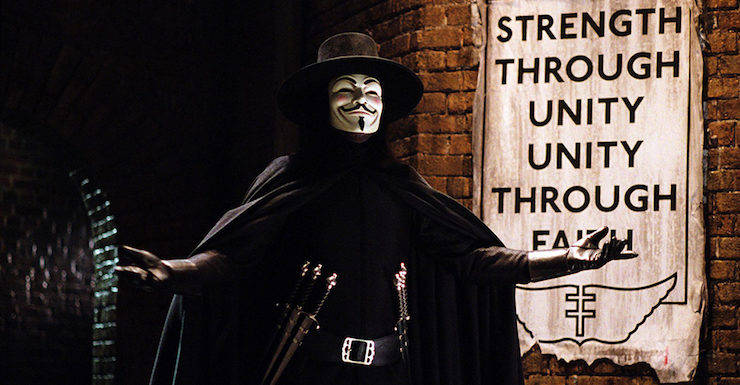
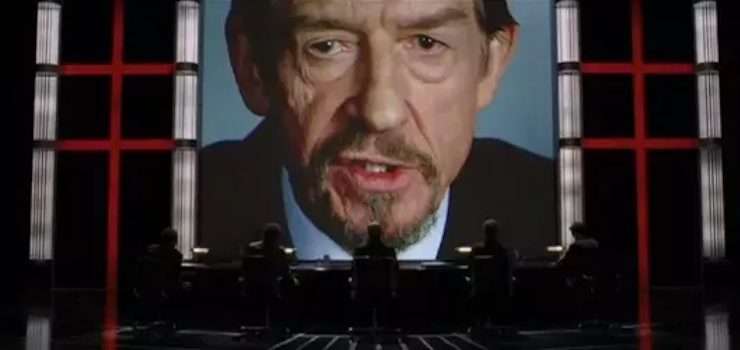

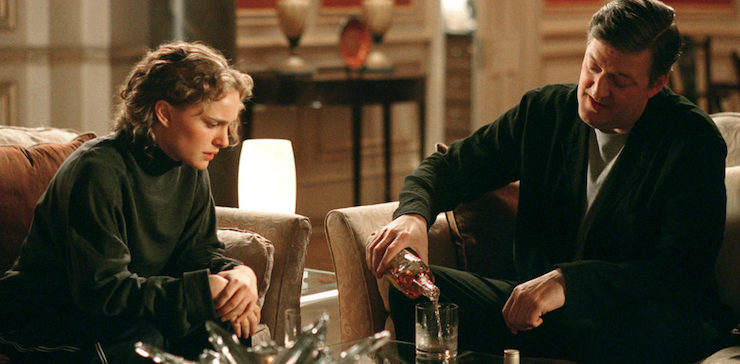

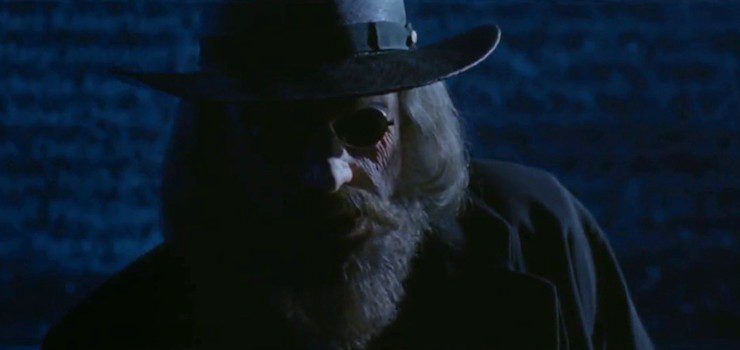
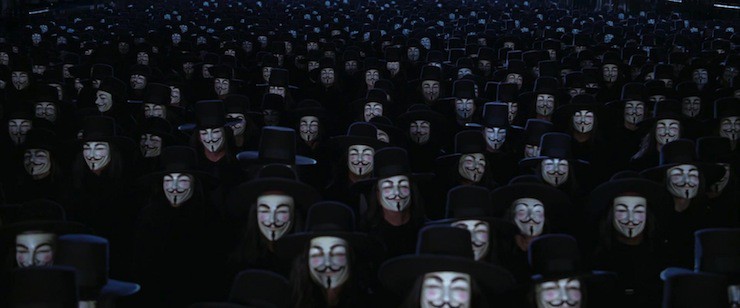
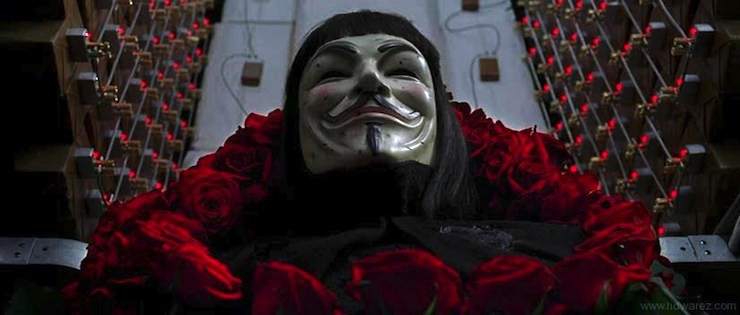
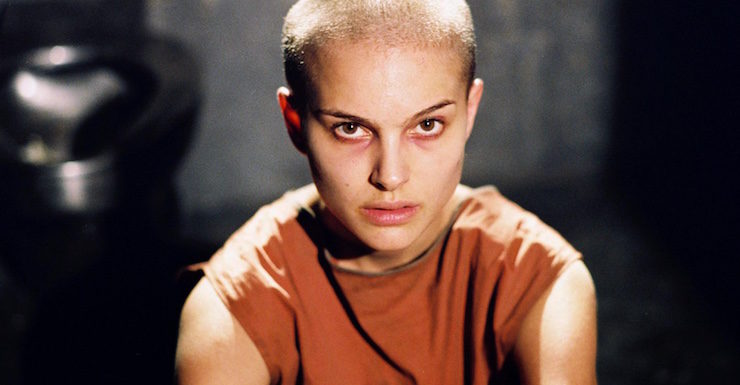
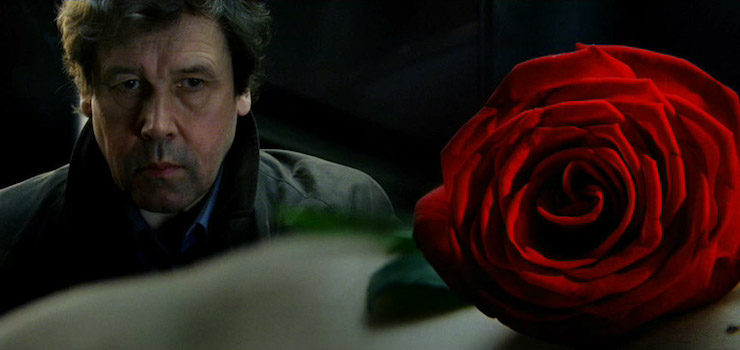
I was quite surprised when I later researched the real Guy Fawkes and learn the same thing you stated in the first paragraph. Guy Fawkes was not about freedom, like this movie would you have believe. It’s really quite strange.
You can’t leave out the best quote!
Austin: I didn’t leave it out — I mined it for the section heads, the headline, and the cut tag. :)
—Keith R.A. DeCandido
Terrorism as a Good Thing. Hmmm. And Guy Fakes is a really weird choice of hero and exemplar.
Ah, another one I really, really like. Not sure I can quite put it on an all time favorites list but it’s close. The selling point for this one is definitely the performances. Everyone really delivers. Very well cast and very well acted.
princessroxana: Keep in mind that two of the Star Trek spinoffs have terrorists as main characters (Kira, Chakotay, Torres). None of them are particularly repentant about their pasts, either.
—Keith R.A. DeCandido
The comic was eh until you look closely at the politics and you realize that V is worse than the bad guys. Rather like going fro the Czar’s oppression to the worse oppression of the Bolsheviks.
The movie made a hash of the story and is even worse.
Worst of all are the stupid anarchists who with no understanding of either political theory or history have adopted the mask as “Anonymous” Lord save us all from the self-righteously stupid…
@6, Amen.
@5, One of the reasons I was never fond of either DS9 or Voyager.
I think ““Yakety Sax” rather than “Yakety Axe”?
Alan Moore’s criticisms of adaptations of his works are… a two edged sword. Like his complains about comics companies and the superhero genre, half the time he seems to have good, solid points and the other half he seems to be just grasping around for things to complain about (“John Constantine SHOULD LOOK JUST LIKE/BE PLAYED by Sting or else he’s not John Constantine!” I know he was the character’s original creator, but characters have a ‘life’ of their own and ultimately most often what they end up being about has only a core resemblance to what they originally were, if anything Constantine’s been more consistent since his starts than most others characters).
He sometimes seem to even miss the point of his own works (he’s so stuck up on The Killing Joke as a mere Batman/Joker story, and the Internet as a whole is so distracted by all the rape imagery, everyone seems to fail to see the core ‘Life is meaningless/Life is meaningful/Life is meaningless BUT we can give it a meaning if we just fight for it’ message of it, which I think is one of the best messages a fictional story can ever deliver).
And of course, as evident from the comparisons between the Evys here, Moore’s female characters rarely have had much agency of their own. The handle of Barbara Gordon’s fridging is the weakest part of Killing Joke, in that once she’s shot she just disappears altogether after motivating Bruce around. The JLU animated episode of For the Man who Has Everything handled Wonder Woman much better than the comic did. The female lead of Neonomicon is just there to be sexualized, and while it’s fair enough to say Lovecraftian protagonists in general only exist to be victimized by forces beyond their control, even Lovecraft himself ocassionally would put a (sadly always male and white) lead who would more or less successfully fight back against the horror, so that’s not much of an excuse. The handling of both Silk Spectres in Watchmen, especially the first one, is also… very problematic, especially in the case of the first.
Even Frank Miller, for all the WHORES WHORES memetism, has the occasional Martha Washington or Commissioner Yindel, a strong, dignified female character with their own agency, but Moore seems to be much worse at that than Miller himself.
@8
Yakety Axe: Benny Hill Meets Game of Thrones.
@10 – brilliant. And in that vein. https://www.youtube.com/watch?v=wQo6hVTSvtU
So, so wrong.
“A dystopian science fiction story, Moore was at least partly inspired by…”
As phrased, this is saying that Alan Moore is a dystopian science fiction story. Which… some people might agree with.
@3 and @5
What is the difference between a terrorist and a freedom fighter again? An insurgency and a popular uprising?
I would think that Americans especially would be appreciative of the right kind of terrorists.
@@@@@ krad and princessroxana
There was also the TNG episode where Crusher was kidnapped by terrorists. I always thought that was a great episode showing both the deadly, horrible and sympathetic sides of terrorism.
@@@@@13
You would think but sadly that is rarely the case.
The distinction is very simple, Freedom Fighters target legitimate military targets. They don’t go in for soft targets and the mass killing of civilians. There is no right kind of terrorist
Terrorism is in the eyes of the victims and the perpetrators.
Also, “Yakety Axe?” I thought it was “Yakety Sax”…
#15) Wonderful distinction, I thank thee.
I haven’t read the comic, so my opinions are only about the movie.
I found it entertaining, with good production and visuals, but I never really understood what it wanted to say.
For me, the problem with V is that, as it was mentioned in the article, we never understand his real motive. Not being able to see his expressions doesn’t help. Also, I didn’t like Portman’s performance.
The other actors are great, Fry is excellent, specially in the comic sketch, I agree with your opinion about Rea and Hurt is always great.
The torture scene message always felt wrong.
I have to admit I’m really fond of that scene when V’s cell mate kisses the other actress in a field. It isn’t particularly brilliant, but I like it for some reason.
Excellent use of 1812 Overture!
Terrorism, at least as we know it today, really wasn’t yet a thing during the American Revolution. The word “terrorist” didn’t come about until the French Revolution, and even then the term meant something a bit different.
When this movie first came out, I was disappointed that it had been Americanized. But with time and some additional perspective brought by distance, I am coming to feel that the movie adaptation is actually better than the original comic. Deitrich especially is an improvement, and Portman is an excellent Evey. As Keith says, the book Evey is hard to imagine as transforming to V. In the film it is easier to see the core of inner strength that is revealed in Evey as life and V break her down.
I also like that V remains an ambiguous character. It must have been difficult for Hollywood not to turn him into a hero.
@15: But the oppression against which “freedom fighters” fight often isn’t military in nature, especially if it’s not based around an external occupation. If a force oppressing a people isn’t military, and there are no legal systems in place to stop that oppression, are you saying there’s no way to combat that oppression without being labelled a terrorist? Oppression and occupation can’t be ended through nonviolent means when there’s no pressure for those nonviolent means to actually enact any consequences on the oppressive or occupying forces. If you can’t vote a fascist or totalitarian government out or pressure them out through nonviolent processes, if there is nothing forcing them to actually listen to the will of the people underneath them, the only other possible paths are violent resistance or capitulation. Is such resistance against government officials suddenly a terrorist act purely because the targets aren’t part of a military? I mean, by that measure, Russian citizens attacking and killing KGB officers would’ve been terrorism, or Nicaraguans attacking CIA agents.
(Also, by that metric Kira wasn’t a terrorist either considering that all her targets were against the Cardassian occupying military despite her self-description of “terrorist”, so I’m not sure what your problem with DS9 is after all then.)
@@@@@ 15. princessroxana
Unfortunately your distinction is not quite so simple. Such a simplistic, blanket statement has just labeled most military commanders throughout history (especially since the US Civil War) as a terrorist.
Was General Sherman a terrorist? Plenty of people in the south still to this day think so.
How about Bomber Harris or Jimmy Doolittle?
Or President Truman for that matter?
hoopmanjh and JasonD: Yes, I derped and used the title of a Chet Atkins/Mark Knopfler song that uses the tune but is about playing guitar. It’s fixed.
—Keith R.A. DeCandido
@22 Eh, Sherman’s not a great example, because the March to the Sea actually was pretty far over the top even if it was against such a horrific opponent. His tactics absolutely aren’t worth approval; he didn’t burn Atlanta because of any moral position against slavery, but because he thought that war was such an awful thing that literally anything was on the table to end it quickly. He was just as eager to commit genocide against the Modoc, Sioux, and Nez Perce in the late 1860s and 1870s during the Indian Wars for exactly the same reason. He was the sort of person that, if he was in the modern era, would be pushing to nuke the enemy and destroy their ability to continue the war so that war would end faster, regardless of who the enemy was.
It amazes me why terrorism is still considered and its points still argued in the post-Gandhi, post-MLK age. The changes made through non-violent protest can be even more effective, and sometimes in rapid order. (Though it doesn’t sell comics and movies, I suppose.)
Isn’t it about time we had another Women’s March? There’s a record number of women running for public office in the United States, by the way. Put away your Halloween masks, boys, and consider that.
@25: As much as it’s awful to say considering their cooperation with Japanese atrocities, the INA was as much a motivating force for the British withdrawal from India as Gandhi, if not more so. And on MLK, I’m just going to drop his own words here. First, from the Letter from a Birmingham Jail:
Second, from a speech to the APA in 1967:
And finally, from a speech to Grosse Point High School in 1968:
He understood the place of political violence as an act against an oppressive force, and he refused to reject it as a method even if it wasn’t a method he himself chose to follow. He understood the causes that led to it, and he supported the motivation behind it, especially when white moderates were too focused on order and civility and doing things the “proper” way.
@25 You ignore that Ghandi’s message only worked because he was able to contrast himself and offer his way as an alternative to political violence, and even then his non-violent protests only started working post-WW2 when England couldn’t afford to keep India anyway. And MLK Jr. was not as peaceable as you paint, and essentially was in the same position as Ghandi due to the alternative positioning of Malcolm X. Violence has its place in the political process, even if it is uncivil.
@25 Non-violent protest assumes an oppressor that cares about the morality of the situation. Otherwise, they just shoot anyone who becomes sufficiently annoying.
Yes, Gandi and MLK were those things too, but our mission should be to correct their mistakes, to build on the peaceful philosophies they started. Using historical texts to rationalize further violence is a tactic as nearly old as violence itself, born of indifference to humanity, juvenile impatience, and a profound lack of imagination.
@21/Idran: It was established at least once, in “The Darkness and the Light,” that Kira and her terror cell had targeted Cardassian civilians, the families of military occupiers. Both because they were seen as invaders too (“You were all guilty and you were all legitimate targets”), and because that’s the whole point of terrorism, to strike against random civilian targets so as to dishearten the enemy and weaken their resolve, or in this case, make their occupation seem too costly to be worth continuing so that they’d choose to pull out themselves, since the Bajorans didn’t have the power to force them out.
@25/Aiden: I don’t think the point is that terrorism is okay, it’s that it’s basically classism to pretend that killing people with expensive bombs and missiles and tanks and armies is somehow nicer and nobler than killing them with makeshift fertilizer bombs and IEDs. Terrorism is just one more means to an end like any other military tactic or weapon. It’s not an ideology or cause in itself. It’s a tactic of the weak against the strong, a tool of psychological warfare to undermine the stronger side’s resolve and willingness to continue when you don’t have the means to win by superior force.
Although powerful armies engage in tactics designed to terrorize an enemy into submission as well; they just use other terms for it, like “shock and awe.”
@29: What do you mean Gandhi was that too? No, Gandhi wasn’t, he absolutely was a pacifist (to the point that at times he questioned if committing violence against Hitler himself would be moral); the point I and random22 were making was that Gandhi wasn’t the motivating force for British withdrawal, he was a contributing force.
And you’re ignoring noblehunter’s point. When the people in charge don’t care about your concerns, and there is no way for them to receive consequences for violent reprisals to nonviolent actions, then how exactly does nonviolent protest actually work? What pressure does it bring against the oppressive force? If nonviolent protest fails, what options remain? Was Stonewall immoral? Was Haymarket?
(Also, this is nitpicking, but neither Gandhi nor MLK started these philosophies, they both built on the philosophies of others that came before them.)
Edit: @30: Ah yeah, that’s fair, I forgot that episode. Thanks!
I had VERY mixed feelings when this came out, but I’ve loosened up since and like it more now. Granted, I still dislike the added romance between V and Evey, and I REALLY wish the widow was a character and still got to kill Sutler/Susan. The latter felt like a missed opportunity because OF COURSE other people would be dissatisfied with this regime and want change. It’s also ironic that for all V’s plans, a random woman with a gun in her coat can just walk up and shoot the dictator. However, they did streamline the movie very well and I like that they made Evey older. Though Deitrich is not interested in women in the movie, in the comic they become “lovers” which is sketchy considering she’s 16 and depending on him for safety.
A small note: I think the hat is a capotain/pilgrim hat, very different from a fedora.
Hi, all–we seem to be straying into the realm of real world politics and history, beyond the scope of the original article and the movie under discussion. Nothing against wide-ranging speculation about the historical and political employment of violence, but this isn’t the best place for it. Let’s try to get back on topic–thanks.
@33 Moderator.
I get where you’re coming from and I’m not complaining but this is a review of a movie that tries to portray a terrorist as sympathetic and perhaps even moral. I think a discussion of just what is or is not a terrorist or act of terrorism and its value or lack of value throughout history is completely justified in this case. Plus so far it has been a completely civil and informative discussion.
Of course this is the internet so that probably wont last much longer. LOL
@35 We appreciate how civil the discussion has been so far, but again, we’ve moved beyond the scope of V for Vendetta and would like to get back to relating these thoughts and opinions to the movie/graphic novel before things inevitably get out of hand or completely off topic.
Thanks, all.
“It was artist David Lloyd who came up with the notion of V wearing a Guy Fawkes mask…”
This in a nutshell is one of the problems with Alan Moore’s working methods and subsequent disavowal of filmed work based on his materials. Comics are a collaborative medium, but it’s not often acknowledged how much the artists working with Moore contribute.
To jumpstart next week, Dave Gibbons has written how chaotic the scripts he got from Moore were while working on Watchmen. They constantly arrived late, incomplete, and even out of order with no page numbers. Gibbons had to do a lot to patch things together. He contributed the famous 9-panel-per-page format, the visual rhymes, and many details not in the script, such as the smiley face on Mars. That’s why I wasn’t worried when Moore opted out of the production, but Gibbons participated. It made perfect sense that the visual artist would work on the film. I will also argue to my dying day that the film’s solution to the threat meant to unify the nuclear nations was far more elegant than the stupid friggin’ psychic space squid. Never been a Lovecraft fan. But then Moore worships an ancient Roman snake god and believes he’s a wizard in real life. Kinda explains how he went off the rails.
As far as V, the Fawkes mask muddles the message. He may have been a political dissenter, but he was advocating a religious cause. Moore credits Lloyd with the idea of the mask: “All of the various fragments in my head suddenly fell into place, united behind the single image of a Guy Fawkes mask.” But it’s a weirdly British mish-mash that wouldn’t have made sense to American audiences unless the symbol was removed from its context. That’s why a similar mask could be used in the show Mr. Robot.
@38/Sunspear: Wasn’t Mr. Robot‘s use of the mask a reference to this very film? Or to some sort of actual protest movement that derived its use from the film?
I love this comic, more than Watchmen, more than Dark Knight Returns, it is what really got me into anti-heroes. When I read it, I wasn’t really that aware of British politics, but the story gripped me tightly anyway.
And in turn, I love this movie. Like the author, I don’t know how much of the body work was Weaving or Purefoy, but his movements really helped convey his emotions. A subtle tilt of the head one way or the other, up or down, gave the fixed smile so many different connotations, from sinister to sad to triumphant.
@CLB: yeah, Keith’s link to Guy Fawkes mask has examples of how it’s been adopted by protesters since the film, including the hacker group Anonymous, which was protesting the Church of Scientology in 2008. It also showed up at Occupy gatherings.
Ironically, it’s a corporate image owned by Time Warner, which gets a cut of the hundreds of thousands of masks sold each year on Amazon.
The interesting thing about V is that for all the british setting, he has a uniquely american view of revolution – the whole One Man Can Make A Difference. In most settings he’d be a hero – the Lone Lawman against a town of villains. Here he’s the opposite, a somewhat unhinged vigilante, obsessed with bringing down those who wronged him, which since they are now the leaders of the land, also involves bringing down their entire order. He’s not a terrorist as we consider them today, since his aim is not in spreading terror, rather it is a deliberately targeted series of attacks at the infrastructure of the State – the media, the church, the security services and the political leadership. He’s probably best described as an agent provocateur, a combination of spy and corrupter. His main tactic is making the enemy do his work for him, turning on themselves and arousing the apathetic citizens by ever harsher cracking down.
Curiously unlike Evey or Finch, V never truly becomes a sympathetic character – even as we start to relate, he does something which undercuts his stance. He’s cultured, but a murderer. He likes music, but also tortures. He can quote erudite texts, and then chop his victims up.
@krad
Since you won’t be reviewing From Hell for this rewatch, I was wondering if you had any thoughts about it.
I haven’t read the graphic novel (although I plan to at some point) so I can’t compare. (I’m assuming Moore’s issue relates to the amount of material cut, given the thickness of the graphic novel and the average runtime of the film.) As a film though, I thought it was a pretty interesting take on Jack the Ripper.
@43/RaymondM: I haven’t seen From Hell, but the AV Club happened to review it just recently, so maybe that can shed some light on your question:
https://www.avclub.com/how-did-a-great-alan-moore-comic-become-a-lousy-johnny-1827785558
RaymondM: I’m the opposite, I’m afraid. I’ve read the comic story — which was my introduction to the amazing artwork of the great Eddie Campbell — but not actually seen the movie. One of these days. (It’s not even remotely a superhero movie, so I can’t really justify including it in this rewatch….)
—Keith R.A. DeCandido
@40. There’s a video interview somewhere (dating from when this movie came out) where Weaving holds up the empty mask and “puppeteers” it around beside him as he speaks, demonstrating just how much can be read into a subtle head-tilt and vocal shift (in the absence of any other facial cues).
@41 The funny thing is that it’s only because they use the specific V for Vendetta mask that TW gets all that extra cash. A “Guy Fawkes mask” isn’t the mask from V for Vendetta, there’s many others they could use – but Anonymous et al aren’t using Guy Fawkes masks, they’re using that particular mask, when they could be using any number of other possibilities. There’s some photos of earlier Guy Fawkes masks over at GeekTyrant.
@42 V reminds me of nothing so much as Reinhard Heydrich; cultured, brilliant and utterly evil in intent and practice. He was the single most dangerous person in the German regime and despite the horrific cost the world was better off with his death. V would have been the same, I believe.
“[V is] a symbol, and the thing about symbols is that they can be interpreted.”
I never thought about it in those terms, but by using the Guy Fawkes mask to oppose fascism, Moore and Lloyd, and then the Wachowskis and McTeigue, took a symbol of theological totalitarianism and turned it into something … well … less evil and more on the side of people against those who would harm and control them.
We’re so used to seeing good (or at least neutral) symbols twisted by evil folks for evil purposes (swastikas, Norse runes, etc.), it’s unusual to see a symbol being turned around the other way.
I seem to recall Stephen Fry saying that he accepted this role simply because his character gets punched and he didn’t want to miss the opportunity to be punched in a bug budget movie.
@38 I also don’t know how much different artists contributed to different Moore works. But have you ever seen the sample scripts that comics sometimes include as bonus content? Moore’s are very tightly specified and detailed; he often includes thumbnails as well It wouldn’t appear that he gives most artists very much leeway for creative interpretation..
V taking the image of Guy Fawkes always seemed to fit for me, because as the story makes clear, V might be fighting for the ‘right’ cause, but his methods are, well, terrible (his imprisonment of Evie is the best example). Equally, Fawkes might have been fighting authority (disrespecting authority is something the British have always enjoyed), but he was planning to do it by killing an enormous number of people. There’s a simultaneous respect and disgust for both V and Fawkes.
Personally I’ve always felt that the masks at the end shouldn’t have been delivered by FedEx, but instead by normal posties in Royal Mail vans. Using the tools to the state to dismantle itself if you will, and more importantly keeping it more British.
@52, phuzz: “Personally I’ve always felt that the masks at the end shouldn’t have been delivered by FedEx, but instead by normal posties in Royal Mail vans. Using the tools to the state to dismantle itself if you will, and more importantly keeping it more British.”
But then the studio would have had to forego the fee that FedEx paid for product placement. Remember what is the true purpose of any film. This is Hollywood, after all
@51. vinsentient: “But have you ever seen the sample scripts that comics sometimes include as bonus content?”
Sure, but I’m sure they selected the best scripts possible. Otherwise, I have no reason to doubt Gibbons’ account of their chaotic working relationship.
Oh I’m not casting doubt on anything Dave Gibbons says. Just noting that Moore is a famous for writing detailed and dense scripts which he prefers to be followed closely, so it is somewhat surprising to me that he would be so scattered on Watchmen.
I seem to remember Dave Gibbons’ interviews about Martha Washington giving me the impression that his collaboration with Frank Miller had plenty of ideas flying in both directions, so he certainly has the talent to do what you are describing.